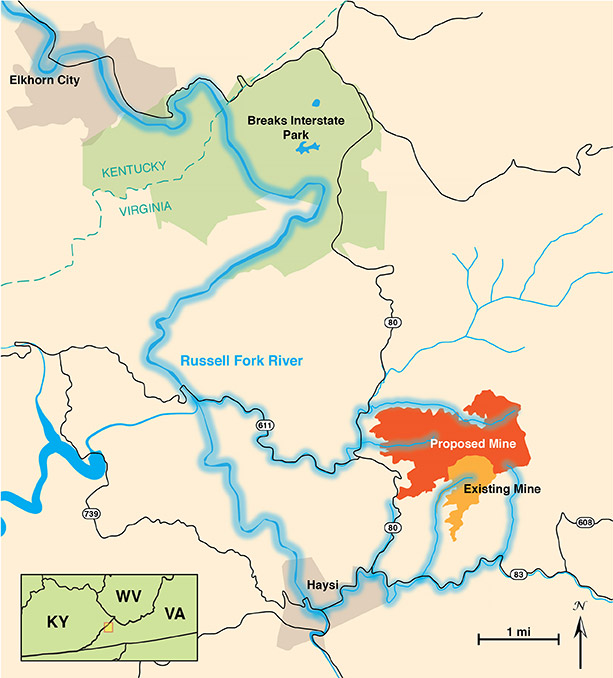Navigating the Russell Fork
Poised to bolster a flagging economy, one river also faces threats from coal mining

Kayakers gather at the finish of the Lord of the Fork Race on the Russell Fork River. Photo by Gareth Tate.
By Erin Savage
The Russell Fork River, with its steep gorge walls, impressive rapids and tranquil pools, is one of the best-known and most-visited rivers in Central Appalachia.
Like many waterways in the region, human activity has impacted the Russell Fork for well over a hundred years. At times, coal mining has had a significant impact, but so too have natural gas drilling, construction, sewage and trash dumping. In general, the Russell Fork’s water quality has improved over the last few decades, due to efforts by local residents and stronger regulations from state and federal governments.
Despite better water quality, the Russell Fork faces new threats from potential coal mining. Last year, Appalachian Voices, the publisher of this newspaper, submitted an application to the national river advocacy group American Rivers asking that the Russell Fork River be included in their 2016 list of America’s Most Endangered Rivers. In April, the annual list — which highlights 10 at-risk waterways — was announced and the Russell Fork was included and ranked at No. 7.
The river’s listing was due to a proposed surface mine in the Russell Fork headwaters known as the Doe Branch Mine. A portion of the current mine proposal was approved back in 2005, but the mine’s future remains unclear, as do its impacts on the Russell Fork watershed. At a time when the coal industry has seen massive declines and the region is grappling with an uncertain future, opinions regarding the mine vary widely.
More Than Just a River
Part of the Big Sandy River Basin, the Russell Fork begins in Dickenson County, Va., and flows north into Pike County, Ky. It is the main attraction at Breaks Interstate Park, which spans the border between the two states. In the park, the river forms one of the deepest gorges east of the Mississippi and is home to the Big Sandy crayfish, which is listed as “threatened” by the U.S. Fish and Wildlife Service.
In an area challenged by the economic realities of a declining coal industry, the Russell Fork and Breaks Interstate Park provide a welcome economic boost for the region. In 2015 alone, visitation to Breaks Interstate Park generated $9.95 million in economic impact.

The Russell Fork River is the main attraction of Breaks Interstate Park, which straddles Virginia and Kentucky.
The 52-mile waterway boasts many recreational opportunities, including fishing, swimming and paddling. The Army Corps of Engineers controls the Flannigan Dam, a flood control dam upstream of the sections most commonly used for rafting and kayaking. In the fall, the reservoir is drawn down, creating predictable weekend flows throughout October. These recreational releases attract intermediate and advanced paddlers from around the country. An annual experts-only race through the gorge at the end of October, the Lord of the Fork Race, includes local and international competitors.
Other regional tourism efforts also contribute to new economic impacts in the region. The annual Cloudsplitter ultrarunning race, which travels beside a portion of the Russell Fork and ends in Elkhorn City, Ky., generated $25,000 in new economic impact in 2015 alone, according to a study by Eastern Kentucky University. Other groups in the region are working with the Army Corps of Engineers and their congressional representatives to potentially increase the number of recreational releases from Flannigan Dam.
The Russell Fork has a dedicated following, including local residents and others from surrounding areas in Kentucky and Virginia. For over a decade, the Friends of the Russell Fork, a small but determined group of community members in and around Haysi, Va., have worked to improve the quality of the watershed and promote the river as a vital cultural and economic resource for the area. Under the leadership of Director Gene Counts, a local kayaker and retired public school administrator, Friends of the Russell Fork has worked with other local leaders, school children and visiting AmeriCorps volunteers to clean illegal dump sites and monitor tributary streams for pollution. The organization has provided steady leadership in advancing sustainable environmental practices throughout the watershed.
“We work with schools within the watershed, teaching students how to monitor the health of our watershed through hands-on microinvertebrate studies,” says Counts. “I believe engaging young people in our home towns is key to maintaining the health of the Russell Fork.”
In 2011, the organization surveyed more than 200 homes along Russell Fork tributaries for sewage straight pipes and faulty septic systems, providing critical information to state agencies with resources to upgrade the communities’ sewage systems.
The river obtains some additional protections through state and federal programs. In 2010 the state of Virginia designated the Russell Fork a Virginia Scenic River. While the designation does not specifically limit human activity in the river corridor, it does help to increase the influence of local residents’ voices in decisions that may impact the river.
The federal Clean Water Act has also led to improvements in water quality for the Russell Fork and its tributaries through more protective regulations and additional monitoring requirements. The law also requires that states keep a list of impaired waterways and develop pollution management plans for these areas. In 1996, Virginia added Russell Prater Creek, a Russell Fork tributary, to the state’s list. The creek was listed due to its diminished ability to support aquatic life. The state identified two types of pollutants, total suspended solids and total dissolved solids, as the most probable stressors.
Identifying Pollutants
Total Dissolved Solids: substances dissolved in water, including minerals, metals and salts. Common sources include sewage, road salt used in the winter, and heavy metals and minerals exposed through mining and dissolved by rain.
Total Suspended Solids: small solid material floating in the water, such as sediment, plant material and sewage. Common sources include sewage, and debris from construction, logging
and mining.
Total Maximum Daily Load: A TMDL is a pollution budget and management plan developed by states for streams and rivers that do not meet water quality standards. The TMDL identifies which pollutants are causing stream impairment and calculates the maximum amount of each pollutant that a waterway should be able to handle while still meeting water quality standards.
In 2006, the state of Virginia proposed — and the U.S. Environmental Protection Agency approved — a pollution budget, known as a total maximum daily load, for Russell Prater Creek. At that time, there were at least 35 mining facilities discharging pollutants into the tributary. The state identified mining as a major contributor to the creek’s poor health, and developed plans for reducing pollution in the watershed. However, the most recent monitoring data from 2014 and 2015 indicate that the watershed is still exceeding its allowed total dissolved solids wasteload by 1,076,907 kilograms per year — more than twice the target limit established by the state.
The Doe Branch Mine
The Doe Branch mine, as currently proposed, would be one of the newest and largest mines in the Russell Fork headwaters. It began as a plan submitted by Paramont Coal for a 245-acre permit in 2005. At that time, Paramont was owned by Alpha Natural Resources, which was one of the largest coal companies in Central Appalachia and in the country. The mine was also slated to be part of a large highway construction project known as the Coalfields Expressway.
The Coalfields Expressway was originally designed in 2001 as a highway to link U.S. Route 23 in Virginia to Interstates 77 and 64 in West Virginia. Early construction plans were hampered by steep terrain and associated high costs. In 2006, the Virginia Department of Transportation began working with Alpha Natural Resources and another coal company, Pioneer Group, to explore an option where surface coal mines would provide the first steps in constructing the roadbed. The new plan significantly changed the route of the highway so that key mines could be worked into the project, including the Doe Branch mine.
The highway project is controversial — supporters claim it would bring much-needed economic development opportunities to the region, but those opposed to the plan feel it unnecessarily enables additional surface mining and does not adequately consider what is best for nearby communities.
“Road construction in the area could benefit the region, at least through short-term employment, and could motivate new industries to move to the region, but only if the project is well thought out and economically viable,” says Matt Hepler of Southern Appalachian Mountain Stewards.
Both Appalachian Voices and Southern Appalachian Mountain Stewards oppose the Coalfields Expressway, as the plan currently stands, due to its reliance on surface mining.
Plans for the Doe Branch Mine and the highway have progressed slowly — as of the last state inspection in June 2016, no mining activity had started and no wastewater was being released, though there had been some logging. In 2012, Paramont applied for a permit modification that would expand the mine by an additional 860 acres. The update would increase the total size of the mine to approximately 1,100 acres, fill four additional valleys with excess rock and dirt, and increase the number of wastewater discharge points from three to 14. Five of the new wastewater discharge points would release into Doe Branch and Wolfpen Branch, which feed into Russell Prater Creek, the Russell Fork tributary already impaired by mining-related pollutants.
That same year, the U.S. Environmental Protection Agency issued an objection to the company’s request to expand the Doe Branch Mine. The EPA’s objection cited inadequate wastewater permit limits and water quality remediation plans, including the fact that the state did not impose numeric limits on the amount of dissolved solids that could be discharged from the mine’s wastewater outfalls.
The company’s 2011 plan included the construction of 16 wetlands to theoretically reduce both total dissolved solids and total suspended solids in the watershed. However, the EPA stated in its objection that wetlands won’t solve the problem. “We also are unaware of any generally accepted, peer-reviewed literature identifying any geochemical process through which wetlands would remove dissolved, as opposed to suspended solids,” regulators wrote. The agency’s objections still stand in 2016.
Current Developments
In August 2015, Alpha Natural Resources filed for Chapter 11 bankruptcy. The bankruptcy was expected and came in a long line of similar bankruptcies filed by other coal mining companies over the last several years. The change slowed but did not halt plans for the Doe Branch Mine.
Alpha’s plan for emergence from bankruptcy was approved by the court in the summer of 2016. The plan involves the formation of two new companies. One is a privately held, smaller Alpha, which will retain most of the Central Appalachian coal mines. The other is Contura Energy, formed by Alpha’s senior lenders, which purchased Alpha’s Wyoming, Pennsylvania and better-performing Central Appalachian mines. Doe Branch is included in the short list of Central Appalachian mines that Contura now owns.
Though Alpha stated earlier this year that its 10-year plan did not include pursuing the Doe Branch Mine, the change in ownership may indicate otherwise. “When Alpha split in two in order to emerge from bankruptcy, it conspicuously loaded all of its valuable assets into Contura, and left the reorganized Alpha with high-liability assets needing to be wound down and reclaimed,” says Sierra Club Staff Attorney Peter Morgan. “Because the Doe Branch Mine went to Contura, it appears clear that the company sees value in the mine and hopes to continue developing it.”
In August 2016, a new draft water pollution permit was published by the Virginia Division of Mine Land Reclamation, for the mining operator now know as Paramont Contura, LLC. The new draft permit still does not impose numeric limits on the amount of dissolved solids that can be discharged from the Doe Branch Mine.
The following month, the EPA notified the state of a general objection to the new draft permit, because the 2012 specific objection regarding the amount of dissolved solids the mine would generate had not yet been resolved. Though the EPA will review the new draft to determine if it resolves the issues raised in 2012, given the lack of changes, it seems likely that they will continue to object. But if Paramont can address the EPA’s concerns, the company could secure the last remaining permit it needs in order to move forward.
International prices for coal have increased recently, driven by demand for steel-making coal in China, which could increase production in Central Appalachia. The construction of the Coalfields Expressway could also shift the economic calculations in favor of moving forward. The plan not only makes road construction cheaper, but also decreases the costs of permitting and reclamation for Paramont.
Environmental groups and concerned citizens are continuing to track the progress of the Doe Branch Mine. Even if the mine moves forward, it is likely that increased oversight from these stakeholders could lead to more stringent and protective permit requirements.
Though the coal-bearing mountains on either side of the Russell Fork are part of what places it at risk, the river’s stunning surroundings are also a reason for optimism. Between decades of local stewardship and growing national concern for this Appalachian treasure, there is a community of advocates watching out for the Russell Fork.
Learn more and take action at americanrivers.org/2016-russell-fork
Related Articles
Latest News

Leave a comment
Your email address will not be published. Required fields are marked *







Leave a Comment